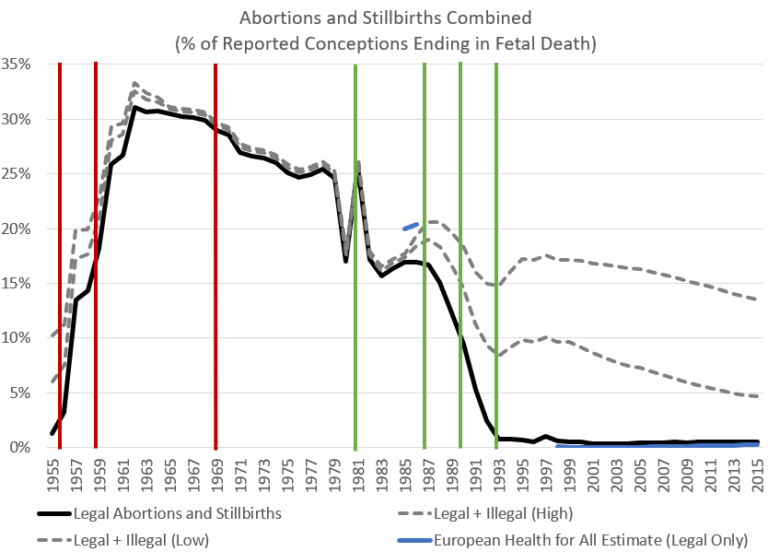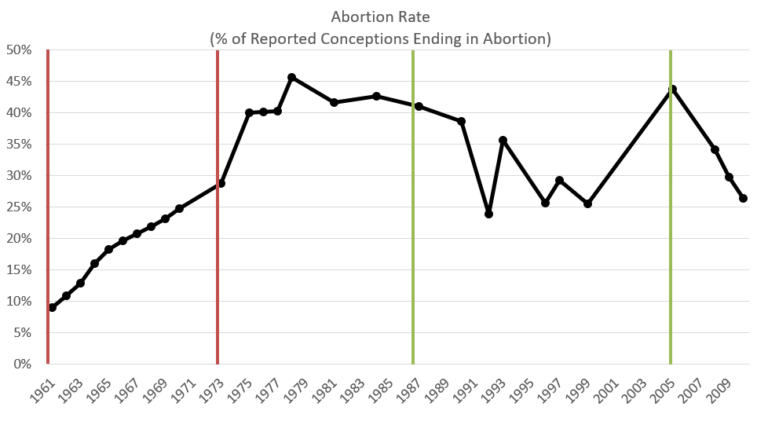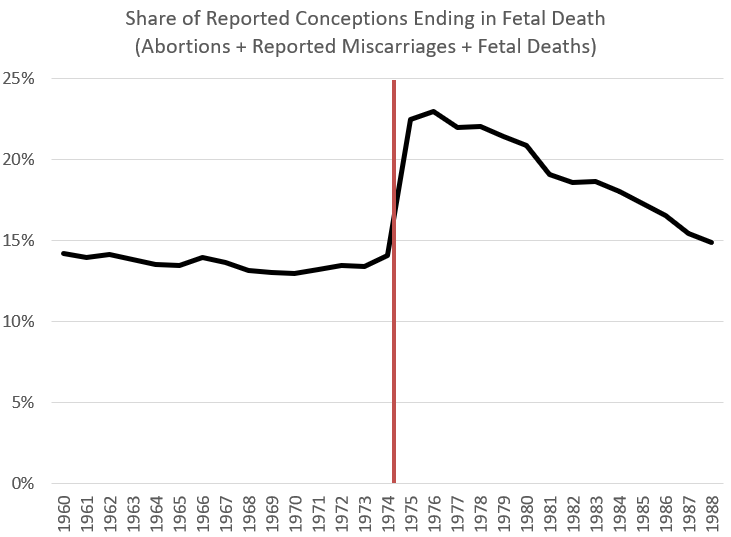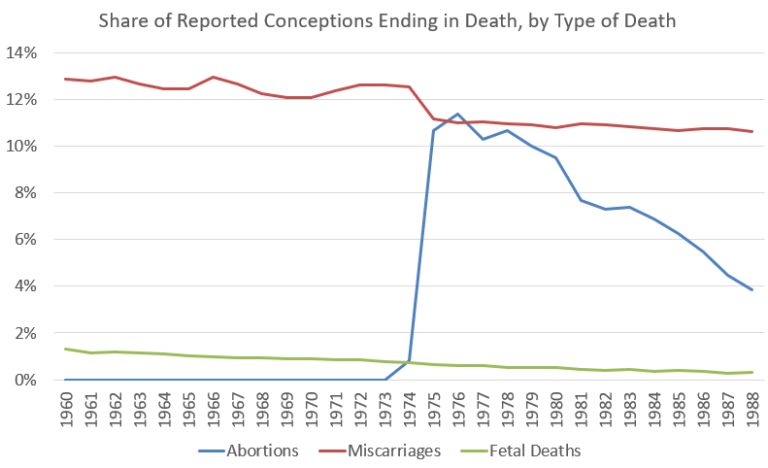Does banning abortion actually reduce abortions? The answer seems obvious. Of course it does. But an undercurrent of left-leaning argument suggests otherwise, that banning abortions won’t reduce abortions, or at least not very much.
The argument comes up a lot; it lurks in the background anytime a progressive says something like, “If you were really pro-life, you would support more welfare for families.” The implicit argument here is that banning abortion won’t save lives but that supporting progressive priorities will, or at least that progressive policies will save more lives.
Perhaps the most recent incarnation of this idea is from David Frum:
Hypothesis: a $500/month per child mother's allowance – not a tax credit, a check – would do more to reduce abortion than any law.
— David Frum (@davidfrum) May 15, 2019
So is this claim true? Would a $500-per-month check reduce abortion by more than, say, a ban?
There’s a simple way to check what effect a change in abortion legality might have. For example, we could look at three example countries to see what happened when they changed their laws.
For completeness’ sake, to the extent possible we’ll try to account for changes in stillbirth, miscarriage, or cross-border abortions, to really see the effect of abortion laws. I include miscarriages and stillbirths because it is possible, and many progressives claim, that abortions often affect children who would have died in the womb anyways. To the extent that increased abortions are offset by reduced stillbirths or miscarriages, abortion supporters would have a point. So wherever data can be found on those other forms of fetal death, I include it.
We’ll start with Poland.
Poland Shows Abortion Laws Do Reduce Abortions
Poland banned abortion from the 1920s until the 1950s when, under pressure from Soviet authorities, they legalized it. During the 1960s, the abortion policy became increasingly liberal, and Poland became a destination for “abortion tourism.”
But then in the late 1980s, as Poland began to secure greater autonomy, incremental measures to reduce abortions began. Then in 1990 and 1993, after the fall of the U.S.S.R., a sweeping law banned abortion in all but a few cases. Since the early 1990s, fewer than a thousand legal abortions have been conducted there per year.
But there are illegal abortions. Estimates of this vary. Progressive groups claim there are more than 150,000 abortions every year performed on Polish women illegally, informally, or abroad. Conservative groups, disagree, and say it’s something more like 5,000 to 20,000.
The graph below shows legal abortions and stillbirths as a share of reported conceptions, as well as the same figure under different assumptions of abortions conducted illegally, informally, or abroad. The high range is lower than progressive groups claim, while the low range is higher than conservative groups claim, as both groups are probably exaggerating for political affect.

As you can see, the legalization of abortions led to a huge increase in abortions. Then over time, as Poland modernized and unwanted fertility declined, abortion rates fell too. Then in 1980s as restrictions were put in place on foreign abortion tourism, and new rules were put in place on how to procure abortions, abortion rates fell sharply. Subsequent legal restrictions successfully reduced the legal abortion rate to essentially zero.
But the true abortion rate probably didn’t fall by as much. Abortion restrictions probably only actually reduced the share of reported conceptions ending in fetal death by between 5 and 10 percent. That is, abortion restrictions probably reduced abortions in the short term by about a quarter to half.
South Korea Shows Abortion Laws Do Reduce Abortions
South Korea banned abortions until 1961. In 1961, South Korea adopted a formal policy trying to reduce birth rates and control population growth. Access to abortion slowly eased over the next decade, but abortion was not generally legalized until 1973.
But in 1987, things started to change. Korean officials became concerned about sex-selective abortion. They began to restrict doctors’ ability to tell parents about the sex of an unborn child. Over the next decade, Korean policymakers and doctors waged a concerted campaign against sex-selective abortion.
Then in 2005, Korea changed its official policy stance from trying to reduce births to trying to increase them. Since then, more restrictions on abortion have been put in place.

When Korea liberalized abortion, abortion rates rose, generally by about 10 percent of reported conceptions within a few years. When Korea took measures to reduce abortion access, abortion rates fell. There is a jump from the 1990s to 2005, but it should be noted the data from 1961 to 1997 is from a different source, which collected its data using a different method, than the data from 2005 to 2010, so that jump may not be real.
In general, increased abortion restrictions tended to be followed by about 10 percentage points lower abortion rates.
Austria Shows Abortion Laws Do Reduce Abortions
But these data sources all have shortcomings. Data collection was inconsistent or interrupted. Plus, while they include stillbirths, they have no measurement of miscarriages.
Data from Austria corrects this deficiency: reliably reported around the window of time Austria legalized abortion, with data on stillbirths and reported miscarriages. While Austria has not restricted abortions, we can at least see what legalizing abortion did.

Legalizing abortion in Austria led to an immediate increase in the share of conceptions ending in death by about 8 percentage points. From then until the end of complete data reporting, fetal deaths fell. But it’s worth looking at why.

Allowing abortion did reduce miscarriages right away. But the cost was enormous, in terms of the lives of children. Many progressives suggest that abortions are vital for women’s health, and to avoid pregnancies that would have ended in death anyways.
An increase in the abortion rate of 11 percentage points led to a reduction in miscarriages of 1 percentage point. There was no meaningful break in the trend of stillborn children. In other words, abortion access had a modest impact on miscarriages, and not on stillbirths. But today, even as abortion rates have fallen by more than half in Austria, miscarriage rates have not risen.
Indeed, what we see in Austria is common in countries around the world, including the United States: even in the absence of legal changes, abortion is becoming rarer, and at virtually no health cost to women and children. Abortion was a crude tool implemented by 20th-century states to manage what was then perceived as excessively high fertility, but whatever function it may have served is now pretty much passed.
Recent U.S. State Policies Have Reduced Abortions
Of course, there’s no shortage of academic research on this topic. A 2017 study of Texas’s 2011 to 2014 abortion regulations found they reduced abortions by 20 percent. Another study of the same regulations found a smaller effect: just a 10 percent decline. A study of abortion legalization in the 1970s found that when a state legalized abortion, births fell by at least 5 percent. The authors find that recriminalizing abortion would result in 320,000 additional births per year.
Another study found that restricting Medicaid funding for abortions could reduce abortions among Medicaid-dependent populations by 22 percent. A study of Texas restrictions imposed in 2004 found that abortions fell by a whopping 88 percent among affected women. Another study suggests repealing Roe v. Wade and allowing states to set their own abortion policies would reduce abortions nationally by 6 to 15 percent. In other words, restricting abortion does reduce abortions, by a lot.
So the view that abortion restrictions simply don’t work is wrong. But of course, it is possible that financial support for women could reduce abortion by even more. There’s less research on this topic. But one clever study has looked at it obliquely.
By exploiting variations in when states adopted modern methods to enforce child support payments, it’s possible to see what happens to abortion rates when women are guaranteed more money to support children. The answer is striking: an approximately $1,000 increase in payments to single moms reduced the abortion rate about 7 percent. Single moms are about half of all moms, so that probably shakes out to about $500 per month to all moms reducing abortions by about 7 percent.
But modest restrictions on abortion, like closing a few centers or reducing Medicaid access, created abortion reductions of between 5 percent and 88 percent. According to one of the studies discussed above, repealing Roe would only reduce abortions by about 6 to 15 percent, because not all states would change their laws. People living in states that restricted abortion would experience enormous declines in abortions.
In other words, giving financial support to parents would indeed reduce abortions. I’ve argued in favor of such financial support in this publication and elsewhere. Pro-life conservatives really should support more subsidies for children and families.
But let’s not kid ourselves. Abortion restrictions work. They have large, rapid effects and save tens of thousands of lives from the cruelty of murder in the womb. While more taxpayer spending on families is important, it is morally imperative that state governments act now against the wholesale slaughter of the unborn.
Yes, if we pay people not to murder the unborn, some people will choose not to do so. But that’s an absurd calculation to make. Abortion is murder, and as murder, should be a crime. So ban it.

